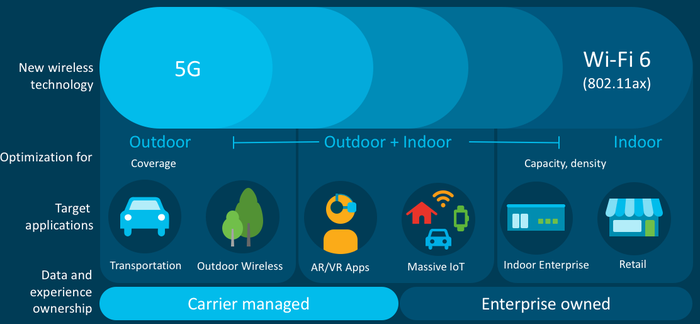Industrial 5G Technology Takes Center Stage
The cellular industry is targeting industrial automation with its IMT-2020 vision, offering technical enhancements over 4G now and expanded capabilities, including TSN, by the end of 2020.
May 15, 2020

The potential use of Industrial 5G on the factory floor took center stage at the recent ODVA conference in Palm Harbor, FL. While Release 16 of 5G technology, which adds support for Time Sensitive Networking (TSN) is still anticipated by the end of 2020, technical enhancements over 4G and a huge marketing push is encouraging manufacturing companies to develop a 5G vision now.
|
Both 5G and Wi-Fi 6 have been extending their technical capabilities, and will create more choices for end users in both indoor and outdoor applications. (Image source: Cisco) |
Industrial 5G and WiFi 6
One of the highlights included a panel discussion: “Can 5G and WiFi 6 Deliver on the Factory Floor?” Participants in the discussion provided insights into the tiered release of 5G and WiFi 6, and what both will mean for manufacturing companies.
Questions about the pricing of plans from the major telecom carriers and use of cellular spectrum by individual companies still remain but the technology itself looks promising for use in factory automation. Manufacturing is being touted and targeted as a key market for 5G, and panel discussion participants from Cisco Systems and HMS Networks provided insights into the encouraging performance of initial testing results.
Even in the short run, 5G seems poised to offer expanded capabilities in the areas of remote monitoring. Use in control applications will require additional testing to address feasibility in this area. 5G proposes to utilize its low latency for real-time control applications, including those in industrial automation.
5G Feature & Benefits
5G is third generation cellular technology (IMT-2020) developed between 2015 and 2018. Its proposed usage for industrial automation highlights three enhanced and expanded feature set in the areas of higher data rates, reduced latency and LPWAN capabilities.
According to the technical presentation at the Conference led by David Brandt, Engineering Fellow at Rockwell Automation, a 20x increase in the peak data rate and low latency of 1 ms (10x improvement) is an enabler for AR/VR applications. It also creates possibilities for motion control applications, but only when combined with high reliability.
Brandt noted that data rates of 100 Mbps at each automation device would match today’s typical expectation for wired Ethernet. A capacity of 10 Mb/s/m2 may begin to enable wireless in each sensor, not just for limited usage, especially if there can be 1 M devices/km2.
The 5G Release 15 is currently released and offers many wireless enhancements, leveraging the legacy LTE control plane. Release 16 currently moving into development brings additional Time Sensitive Networking (TSN) capabilities and is targeting industrial automation use case requirements.
Looking into the Future
New 5G technology is already emerging, even though important enhancements for industrial automation are still in the future. The marketing push is on and seems poised to expand the use of wireless technology in factory automation. Brandt said there are two areas where 5G Release 16 could provide solutions. One vision is the replacement of wired switches with 5G wireless. Supervisory control may be a good candidate due to the lower rates to interlock and coordinate across equipment, and the larger distances of cable runs.
A second potential application area is lean collaborative mobile manufacturing systems. Replacing Ethernet with wireless untethers the equipment to move materials (AGVs) or mobile platforms can also be used to carry parts-in-process between manufacturing subsystems.
5G technology is certainly already demonstrating advanced capabilities and enhancements, even though they are limited for now, compared to 4G. Release 16 completed anticipated by the end of 2020 will be the next step in the tiered rollout that has potential new benefits for factory automation.
View Technical Papers
Here is a link to download the technical papers presented at the Conference to learn more.
RELATED ARTICLES:
Al Presher is a veteran contributing writer for Design News, covering automation and control, motion control, power transmission, robotics, and fluid power.
About the Author(s)
You May Also Like




